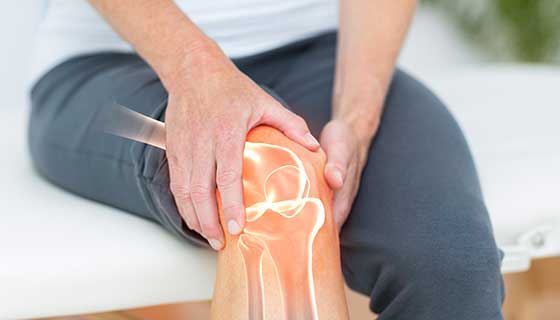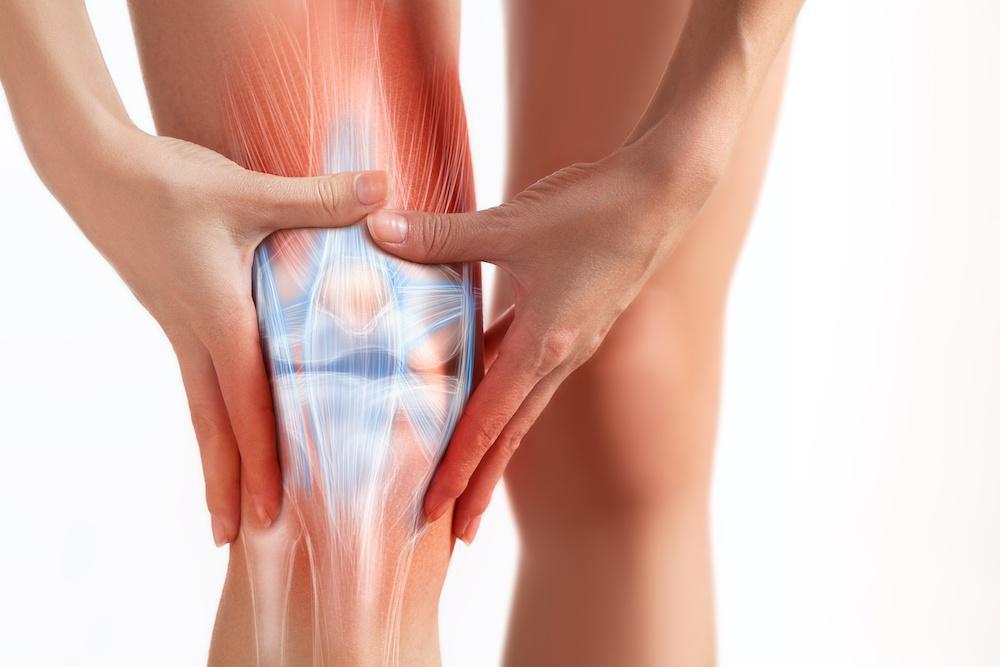Knee pain is an extremely common complaint affecting people of all ages and backgrounds. It is often the result of repetitive use or injuries, but it can also be caused by various conditions. Knowing the possible causes of knee pain, associated symptoms, and available treatments can help you decide how to address your knee pain. With that in mind, the following is a brief overview of knee pain.
What Is Knee Pain?
Knee pain is any type of pain felt in or around the knee joint. Types of knee pain can vary from mild to severe and may range from a dull ache to a sharp stabbing sensation. The pain can also worsen when you move your knee or put pressure on it. In some cases, basic home care and rest can help resolve whatever knee pain you’re experiencing.
However, certain underlying causes may require more extensive treatment. In fact, without a proper diagnosis of the issue causing your knee pain, treatment options may be limited and ineffective. This is because you’ll essentially be treating the pain and not its underlying cause.
For example, say you’re experiencing knee pain due to sciatic nerve compression. Sciatic nerve compression occurs when the sciatic nerve is compressed due to a slipped disc or bone spur in your lower back. Because the sciatic nerve runs from your lower back down to your legs, sciatic nerve compression can result in knee pain. In this case, simply resting the knee won’t do anything to help relieve pain. Nor will operating on your knee — since it’s not the knee that’s causing the pain. To find knee pain relief, you’ll need to treat the underlying condition causing it.
Knee Diagram And Location Of Pain
The joint of the knee consists of three bones: the femur (thigh bone), tibia (shin bone), and patella (knee cap). These bones are connected by four major ligaments and several other smaller ligaments. Pain in the knee can be located in any of these areas, including the muscles, tendons, ligaments, or cartilage. The location of the pain can help guide diagnosis and treatment.
For example, pain in the front of the knee may be due to a patellar dislocation or jumper’s knee. If you experience pain on the outer side of the knee, it may be due to a meniscus tear, while pain on the inner side of the knee could be due to an Iliotibial Band Syndrome.
What Causes Knee Pain?
Because the knee joint is so complex, there can be a variety of causes for knee pain. These include the following:
Knee Injuries
Knee injuries are one of the most common causes of knee pain. These can be caused by accidents or falls, as well as sports-related activities such as running, jumping, and kicking. They can result from an impact, twisting motion, or hyperextension of the ligaments in the knee joint.
Common knee injuries include fractures, dislocations, ligament tears, tendonitis, and meniscus tears. The severity of the injury can vary, with some requiring medical attention for proper treatment and others that can be managed with rest and home care.
Sprains And Torn Cartilage
A sudden twist or impact to the knee usually causes sprains and torn cartilage. These injuries occur when the ligaments that connect the bones of the knee are overstretched or torn, causing pain and swelling. The type of pain caused by sprains and torn cartilage can range from mild to severe.
Arthritis
Arthritis is a condition that causes the joints to become inflamed. There are several types of arthritis, which include osteoarthritis, rheumatoid arthritis, and gout.
Osteoarthritis is the most common type, and it occurs when the cartilage between joints wears away over time. The most common symptom of arthritis is aching or stiffness in the joints, but it can also cause swelling and tenderness.
Chronic Overuse
Chronic overuse can also cause knee pain, especially in athletes and people who engage in repetitive activities. Repetitive movements can lead to inflammation of the tendons and ligaments, resulting in pain. Overuse injuries are usually caused by overtraining or insufficient rest between workouts.
Other Symptoms Associated With Knee Pain
In addition to the pain, other symptoms may be present depending on the underlying cause. These can include the following:
Swelling and Stiffness
Knee joint swelling and stiffness are common symptoms associated with knee pain. Swelling occurs when there is inflammation in the area due to an injury or overuse.
A swollen knee can make moving difficult and put additional pressure on the joint. Stiffness is usually a result of muscle or tendon tightness, which can cause discomfort and limit the range of motion. Various conditions, including arthritis, gout, bursitis, and tendonitis, can cause knee stiffness.
Pain often contributes to another cause of swelling and stiffness: muscle loss and inactivity. This, in turn, can lead to further degeneration and inflammation.
Popping or Crunching Sound
Also called “crepitus,” a popping or crunching sound in the knee is often a sign of osteoarthritis behind the kneecap, often resulting in patellofemoral dysfunction. The back of your kneecap and the front of your thigh are covered with cartilage. The cartilage on the front of your thigh bone forms a groove that allows the kneecap to move smoothly up and down in a floating position. When the cartilage wears down, the kneecap cannot glide smoothly, leading to knee crepitus.
Pain During Activities
Several factors can cause knee pain and stiffness during and after physical activities, including damaged tendons or ligaments, arthritis, and infection.
Unable to Bend or Straighten the Knee
If you can’t bend or straighten the knee, it could be a sign of a ligament tear or meniscus injury, both of which require medical attention and treatment. In addition to the pain, you may also experience a sensation of instability when attempting to move the joint.
Difficulty In Walking
Difficulty walking can also be a symptom of knee pain, especially if the pain is related to arthritis or an overuse injury. If your knees are too painful to bear weight, you may have difficulty walking or climbing stairs. In some cases, you may even find it difficult to stand up straight due to the pain in your knees.
Joint Pain And Swelling
Joint pain is arguably one of the most common musculoskeletal complaints among adults of all ages. But the fact that this condition is so widespread does not mean that it isn't life-limiting, or that it should be overlooked. Joint pain and swelling can cause...
Reduced Knee Mobility
In our everyday life, we perform movements such as walking, jogging, climbing stairs, or bending down to tie our shoes almost automatically. And, if we are able to perform these movements, it is thanks to the knee’s complex structure of bones, ligaments,...
Stiffness and Limited Range of Motion
Although it’s normal for people to experience some level of stiffness or reduced range of motion as they age, it may be a sign of an underlying health condition if the issue persists or is causing significant discomfort. When the range of motion of a joint...
Tendon Pain Behind Knee
Tendons are the fibrous tissues connecting your muscle to your bone. They enable the muscle to move the bone by contracting. When a tendon is damaged or overworked, it can cause pain in the back of your knee, which can be very uncomfortable and debilitating....
Diagnosis Of Knee Pain
If you experience knee pain that simply will not go away, it is crucial to seek medical attention. Diagnosis of knee pain will depend on the underlying cause and your symptoms.
To determine the cause of your knee pain, your doctor will likely ask questions about your health history and perform a physical examination. This may include assessing your range of motion, testing reflexes, and noting the location of pain and inflammation.
A doctor will typically order imaging, such as an X-ray or MRI, to further diagnose your condition. For example, an X-ray can help detect bone fractures or arthritis, while an MRI can help identify torn ligaments and tendons.
Finally, blood tests may be ordered to rule out underlying diseases or infections. These tests can help a doctor determine the best treatment plan for your knee pain.
Treatment Options for Knee Pain
The treatment for knee pain will depend on the underlying cause. In some cases, conservative treatments, such as at-home rest or physical therapy, can help alleviate pain and reduce inflammation.
However, chronic knee pain, on the other hand, may require more extensive treatment. It’s also worth noting that different healthcare providers may recommend treatments based on the individual case. The following are some of the typical treatment options that conventional healthcare providers may suggest to treat knee pain:
Medication
Your doctor may recommend taking over-the-counter medications such as ibuprofen or acetaminophen to help provide temporary pain and inflammation relief. If you’re struggling with severe knee pain, many healthcare providers will also prescribe stronger drugs such as steroids or narcotic painkillers. However, these types of medications only address the symptoms and do not address the underlying causes of knee pain. Additionally, many pain relief medications (especially opioid medications) can be highly addictive and may have adverse side effects.
Physical Therapy
Physical therapy can be a valuable tool in treating knee pain by addressing specific patient needs and providing a personalized rehabilitation program. The program may include patient education, pain management techniques, range-of-motion exercises, manual therapy, muscle strengthening, functional training, and the use of assistive devices such as braces and walking aids.
In addition to being an effective treatment option on its own, physical therapy is also a valuable part of the pre and post-operative care for patients undergoing more interventional treatments, such as knee surgery. Prior to surgery, physical therapy can help improve the patient’s strength, mobility, and range of motion, which can help with the recovery process.
Surgery
In more serious cases, surgery may be recommended to treat knee pain. Surgery is typically reserved for more serious conditions such as a torn ligament or severe arthritis. Depending on the condition, surgery can help repair the joint or remove any damaged tissue to reduce pain and inflammation. In some cases, a total knee replacement may be recommended to replace a severely damaged joint.
However, surgery should be considered a last resort as it comes with several risks. First of all, surgery can be costly and may require a lengthy recovery period. Additionally, there is always the risk of potential complications such as infection or nerve damage. Finally, there’s no guarantee that surgery will permanently fix the issue. You may still experience knee pain and other symptoms even after the surgery.
Regenerative Therapies
Finally, regenerative therapies such as platelet-rich plasma (PRP) or stem cell therapy may be an option for some people with knee pain. These therapies utilize natural proteins and stem cells to promote healing and reduce inflammation in the joint. Although these treatments are relatively new, many healthcare providers have seen positive results in their patients. Additionally, regenerative therapies are non-invasive and do not come with as many risks as surgery. However, it’s essential to remember that these treatments may not be covered by insurance and can also be costly. Not to mention, the results are not guaranteed.
How Neurofunctional Pain Management Helps Knee Pain
Instead of using more traditional methods such as medication and surgery to treat knee pain, the Neuragenex Neurofunctional Pain Management (NFPM) protocols implement a safer, more whole-person approach to treating knee pain. We use NFPM to address and target the underlying cause of knee pain and provide more effective, long-term results.
Our protocol begins with a comprehensive evaluation to determine the root cause of knee pain. We then create a personalized treatment plan that includes the following treatments — all without relying on pain medications or invasive procedures to treat pain.
Electroanalgesia
Electroanalgesia is a pain management technique that uses high-pulse electrical current to ease pain, boost blood circulation, improve mobility, and induce...
IV Therapy
IV nutritional therapy, or intravenous therapy, involves administering vital nutrients directly to the bloodstream through an IV. This type of treatment bypasses the digestive system, allowing for maximum absorption and utilization of nutrients by the...
Lifestyle Counseling
Lifestyle counseling is an approach to managing chronic pain that involves identifying, assessing, and modifying lifestyle factors contributing to an individual's pain. For example, lifestyle factors such as nutrition, physical activity, stress, sleep quality...
You Deserve A Safe And Effective Knee Pain Treatment
We believe that everyone deserves a safe and effective solution to their knee pain. The whole-person approach we use in treating knee pain helps target the underlying cause of the condition and provides relief without relying on dangerous medications or invasive procedures.
Our personalized treatment plan is tailored to each patient’s needs, allowing them to return to a normal lifestyle quickly and effectively. With our team of experienced professionals, you can trust that you’ll receive the highest quality care for your knee pain.
Get proper treatment for your knee pain. Get started today with the Neuragenex NFPM protocol.








